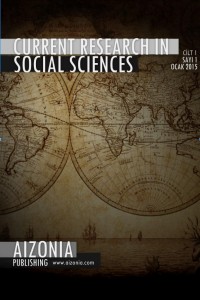Öz
Dinar (golden coin) and dirham (silver coin) were usual payment tools in the vision of islamic economy. Muslim governments did not have an influence upon the traditional payment tools of newly conquered lands. Therefore, the money transition about golden and silver coins in the taken lands occured slowly in the duration of one or two century. There were different currency systems in some marginal regions like Bahrain and el-Ahsâ controlled by Qarmatian because of different reasons. There were some extraordinary payments tools such as bronze, lead coins, the fur of squirrel, the piece of silk and fabric, oyster crust
Anahtar Kelimeler
Islamic Economics Economics of the Middle Ages Currency Monetary System
Kaynakça
- Aknerli Grigor. (1954). Moğol Tarihi (Çev. Hrand D. Andreas- yan). İstanbul: İÜEF Yay. No: 582.
- Atan, T. (1990). Türk Gümrük Tarihi I. Ankara.
- Bakır, A. (2001). Ortaçağ İslam Dünyasında Taş ve Toprak Ma- mulleri Sanayi. Ankara.
- Bundârî. (1943). Zübdetü’n-Nüsrâ ve Nuhbetü’l-Usrâ (Çev. Kıva- meddin Burslan). Irak ve Horasan Selçukluları Tarihi. İstanbul. Cipolla, C. M. (1993). Akdeniz Dünyasında Para, Fiyatlar ve Medeniyet (Çev. A. İ. Karacan). İstanbul.
- Cüveynî, Alaaddîn Ata Melik. (1998). Tarîh-i Cihan Güşa (Çev. M. Öztürk). Ankara.
- Eagleton, C., Williams, J. (2011). Paranın Tarihi. (Çev. F. Kah- ya). İstanbul.
- Gırnatî, Ebu Hamîd Muhammed. (2011). Tuhfetu’l-Elbâb ve Nuhbetu’l-A’câb (Haz. F. Sabuncu). Gırnatî Seyahatnamesi. İs- tanbul.
- İbn Battuta, Ebu Abdullah Muhammed Tancî. (2004). Tuhfetü’n- Nuzzâr fî Garâibi’l-Emsâr ve Acâibi’l-Esfâr (Çev. A. Sait Aykut). Seyahatname I-II. İstanbul.
- İbn Bîbî, el-Hüseyin b. Muhammed b. Ali el-Ca’ferî er-Rugadî. (1996). el-Evâmiru’l-Alâiye fî Umûri’l-Alâiye I-II (Haz. M. Öz- türk). Ankara.
- İbn Fadlan. (1995). Seyahatnâme (Çev. R. Şeşen). İstanbul.
- İnci, Ö. (1978). XI. Yüzyıla Kadar Orta Asya Türk Devletlerinin Çin’le Yaptığı Ticarî Münasebetler. Tarih Enstitüsü Dergisi, 9, 87-106.
- İnci, Ö. (1987). Uygurların Siyasi ve Kültürel Tarihi (Hukuk Ve- sikalarına Göre). Ankara.
- Nâsır-ı Husrev. (1950). Sefernâme (Çev. Abdülvehap Tarzi). İs- tanbul.
- Özdal, A. N. (2013). İslam İktisadi Coğrafyasında İş Yaşamı, Ti- caret ve Tüccar (X. – XIV. Yüzyıllar), Yayımlanmamış doktora tezi, Atatürk Üniversitesi, Erzurum.
- Sédillot, R. (2005). Değiş Tokuştan Süpermarkete (Çev. E.M. Erendor). Ankara.
- Serahsî. (2008). Mebsût, I-XXX (Ed. M. C. Akşit). İstanbul.
- Sıbt İbnü’l-Cevzî. (2005). Mir’âtü’z-Zamân fî Târihi’l-Ayân (Haz. A. Sevim). Makaleler – 2. Ankara.
Öz
İslam iktisadi tasavvurundaki olağan ödeme araçları, altın para (dinar) ve gümüş para (dirhem) idi. Ancak Müslüman yönetimler, yeni fethedilen yerlerdeki geleneksel (örfî) ödeme araçlarına doğrudan müdahalede bulunmuyorlardı. Böylece bu yerlerde altın ve gümüş bazlı para sistemlerine geçişler biriki yüzyıla yayılan bir yavaşlıkta gerçekleşiyordu. Karmatî yönetimindeki Bahreyn ve el-Ahsâ gibi bazı marjinal bölgelerde ise daha farklı nedenlerden dolayı farklı para sistemi uygulamaları görülmüştü. Bu sıra dışı ödeme araçları arasında, tunç, kurşun paralar, sincap derisi, ipek veya kumaş parçaları, istiridye kabukları vs. bulunmaktaydı
Anahtar Kelimeler
Kaynakça
- Aknerli Grigor. (1954). Moğol Tarihi (Çev. Hrand D. Andreas- yan). İstanbul: İÜEF Yay. No: 582.
- Atan, T. (1990). Türk Gümrük Tarihi I. Ankara.
- Bakır, A. (2001). Ortaçağ İslam Dünyasında Taş ve Toprak Ma- mulleri Sanayi. Ankara.
- Bundârî. (1943). Zübdetü’n-Nüsrâ ve Nuhbetü’l-Usrâ (Çev. Kıva- meddin Burslan). Irak ve Horasan Selçukluları Tarihi. İstanbul. Cipolla, C. M. (1993). Akdeniz Dünyasında Para, Fiyatlar ve Medeniyet (Çev. A. İ. Karacan). İstanbul.
- Cüveynî, Alaaddîn Ata Melik. (1998). Tarîh-i Cihan Güşa (Çev. M. Öztürk). Ankara.
- Eagleton, C., Williams, J. (2011). Paranın Tarihi. (Çev. F. Kah- ya). İstanbul.
- Gırnatî, Ebu Hamîd Muhammed. (2011). Tuhfetu’l-Elbâb ve Nuhbetu’l-A’câb (Haz. F. Sabuncu). Gırnatî Seyahatnamesi. İs- tanbul.
- İbn Battuta, Ebu Abdullah Muhammed Tancî. (2004). Tuhfetü’n- Nuzzâr fî Garâibi’l-Emsâr ve Acâibi’l-Esfâr (Çev. A. Sait Aykut). Seyahatname I-II. İstanbul.
- İbn Bîbî, el-Hüseyin b. Muhammed b. Ali el-Ca’ferî er-Rugadî. (1996). el-Evâmiru’l-Alâiye fî Umûri’l-Alâiye I-II (Haz. M. Öz- türk). Ankara.
- İbn Fadlan. (1995). Seyahatnâme (Çev. R. Şeşen). İstanbul.
- İnci, Ö. (1978). XI. Yüzyıla Kadar Orta Asya Türk Devletlerinin Çin’le Yaptığı Ticarî Münasebetler. Tarih Enstitüsü Dergisi, 9, 87-106.
- İnci, Ö. (1987). Uygurların Siyasi ve Kültürel Tarihi (Hukuk Ve- sikalarına Göre). Ankara.
- Nâsır-ı Husrev. (1950). Sefernâme (Çev. Abdülvehap Tarzi). İs- tanbul.
- Özdal, A. N. (2013). İslam İktisadi Coğrafyasında İş Yaşamı, Ti- caret ve Tüccar (X. – XIV. Yüzyıllar), Yayımlanmamış doktora tezi, Atatürk Üniversitesi, Erzurum.
- Sédillot, R. (2005). Değiş Tokuştan Süpermarkete (Çev. E.M. Erendor). Ankara.
- Serahsî. (2008). Mebsût, I-XXX (Ed. M. C. Akşit). İstanbul.
- Sıbt İbnü’l-Cevzî. (2005). Mir’âtü’z-Zamân fî Târihi’l-Ayân (Haz. A. Sevim). Makaleler – 2. Ankara.
Ayrıntılar
| Birincil Dil | Türkçe |
|---|---|
| Bölüm | Araştırma Makalesi |
| Yazarlar | |
| Yayımlanma Tarihi | 29 Nisan 2015 |
| Yayımlandığı Sayı | Yıl 2015 Cilt: 1 Sayı: 1 |
Bizi sosyal medyadan takip edin!
![]() https://twitter.com/AizoniaPublish
https://twitter.com/AizoniaPublish
![]() https://instagram.com/aizoniapublishing
https://instagram.com/aizoniapublishing


